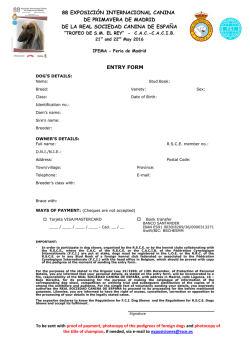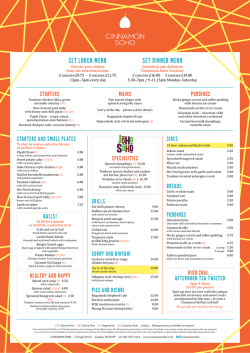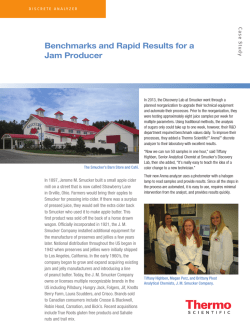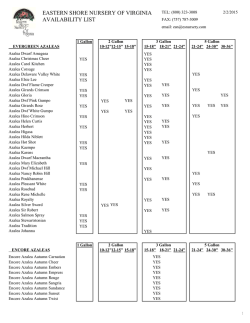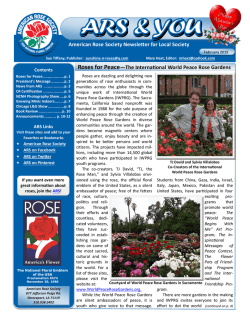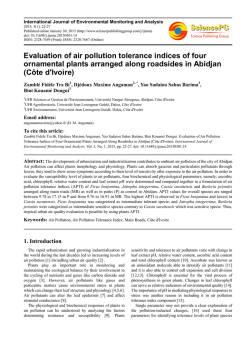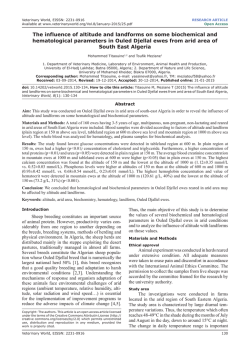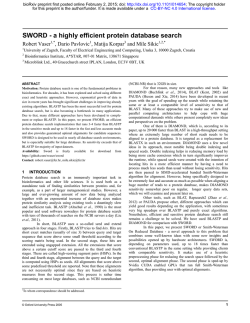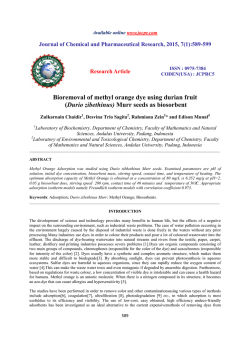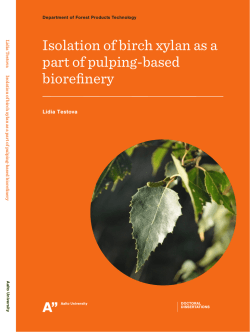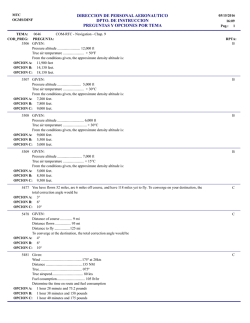
PDF (279KB)
Letter to the Editor Iran J Public Health, Vol. 44, No.1, Jan 2015, pp.138-139 Ascorbic Acid Content of Rose Hip Fruit Depending on Altitude * Lăcrămioara OPRICA, Cristina BUCSA, Maria Magdalena ZAMFIRACHE Faculty of Biology, Alexandru Ioan Cuza University, Iasi, Romania *Corresponding Author: Email: [email protected] (Received 10 Oct 2014; accepted 05 Nov 2014) Dear Editor-in-Chief Fruits along with vegetables are major contributors to our daily vitamin requirements. Both, fruits and vegetables are very important for health because the nutrient contribution is dependent on the amount of vitamins present in these, as well as the amount consumed (1). Vitamin C or ascorbic acid (hereafter AA) is a water-soluble vitamin, which has an important role in all processes of oxidoreductions by neutralizing the free radicals that are harmful to the body (3). Rose hip fruits are known as medicines since prehistoric times and ascorbic acid is concentrated in the rose hip flesh. Rose hip fruit is used mainly in the support therapies in the cases of AA deficiency (1). More than, rose hip tea is responsible for the antioxidant activity because the high content of vitamin C and flavonoids (4). The gender Rosa L. includes many species and in Romania, it is well represented in the spontaneous flora (23 species described) (5). Regarding the maturity of fruits, AA content in Rosa canina fruits is higher in full ripe and half-ripe samples than in ones unripe (6). Rosa specie has long been used as an herbal tea, vitamin supplement or food product in many European countries, as it is rich in AA (7). The medicinal value of rose hips depends primarily on the content of vitamin C and flavonoids (8). During harvest season (end of September and beginning of October 2013) samples of rose hips representing six species (Rosa pendulina, R. tomentosa, R. canina, R. rubiginosa, R. corymbifera and R. nitidula) were collected from spontaneous flora of Suceava district from different altitudes ranging between 138 807m and 830m (Table 1). Ascorbic acid content assay was affected using method with potassium ferricyanide (9) The AA amount of all rose hips species studied, calculated as mg/100g FW, were found to range between 274.26 mg% (R. canina) and 1157.88 mg% FW (R. nitidula) in pulp (Table 1). The level of AA contained from the seeds was lower and varied from 18.30 mg% (R. canina) to 44.68 mg% (R. nitidula). Both in seed and pulp, the lowest content of AA was recorded in R. canina picked up from low altitude (630m) whereas the highest content was found in R. nitidula collected from high altitude (830m). From all the species collected from different altitude R. canina has the lowest content of AA. In addition, the content of AA in R. canina was doubled with rise of altitude both in pulp and seeds. In agreement with our results, ROMAN and co-workers (2013) found an increase in AA content with altitude in the same species (10). Regarding the content of AA from the other rose hips species taken into study, the results indicated a large variability. Therefore, in pulp the amount was bigger at the high altitude 807m (968.55 mg% in R. pendulina, 853.12 mg% in R. tomentosa) and 830m (923.74 mg% in R. corymbifera and 1157.883 mg% in R. nitidula). As expected, in seeds was observed the same bigger values at two of altitudes 807m and 830m at the same species. In previous studies, a great variability in vitamin C content of rose hips was also found. Moreover, several research have pointed that the rose hips, from different agro-climatic regions of Turkey, are Available at: http://ijph.tums.ac.ir Oprica et al.: Ascorbic Acid Content of Rose Hip Fruit … a rich source of AA and the content ranged from 106 to 2712 mg/100 g in (11). The authors conclude that contents of AA were found in this study, to differ greatly between the rose species as well as various parts of fruits (pulp and seeds). The difference in AA compositions of the fruits could be caused by the species, variety, ecological factors, and altitude. Moreover, the lowest content of AA was recorded in R. canina harvested from low altitude whereas the highest content was found in R. nitidula collected from high altitude. Table 1: Ascorbic acid content fruit pulp, and seeds of the rose hip species (mg/100g FW)a Romanian sampling areas (Altitude) Dorna Candreni (830 m) Species R. corymbifera R. nitidula Vatra Dornei (807 m) R.pendulina R. tomentosa R. canina Campulung Moldovenesc (630m) R. rubiginosa R. canina a all pulp seeds pulp seeds pulp seeds pulp seeds pulp seeds pulp seeds pulp seeds Average±ES 923.74±21.52 29.06±6.12 1157.88±49.29 44.68±1.63 968.55±121.03 27.81±2.02 853.12±121.70 26.63±3.84 449.91±80.22 25.54±0.51 783.61±90.18 24.916±3.76 274.26±5.87 18.30±1.06 data represent the mean of three determinations Acknowledgments The authors declare that there is no conflict of interests. 6. References 1. Oke M, Jacob JK, Paliyath G (2012). Biochemistry of fruit processing. In: Food Biochemistry and food processing Eds. Benjanin K. Simpson, 2nd ed, Wiley-Blackwell, pp. 554-557. 2. Ropciuc S, Cenusa R, Caprita R, Cretescu I (2011). Study on the ascorbic acid content of rosehip fruits depending on stationary conditions. Anim Sci Biotechnol, 44 (2): 129-132. 3. Bojor O (1997). Plantele medicinale si aromatice de la A la Z., Ulpia Traian Ed., Bucureşti, pp. 55-57. 4. Tumbas VT, Canadanovic-Brunet JM, Cetojevic-Simin DD, Cetojevic-Simin GS, Ethilas SM, Gille L (2012). Effect of rosehip (Rosa canina L.) phytochemicals on stable free radicals and human cancer cells. J Sci Food Agric, 92(6):1273-1278. 5. Bucsa C, Atofani D, Oprica L (2013). Contribution on the biochemical composition in fruits of two Rosa L. taxa from the spontaneous flora. Lucrarile Available at: http://ijph.tums.ac.ir 7. 8. 9. 10. 11. Stiintifice, Seria Horticultura, USAMV ”Ion Ionescu de la Brad”, 2: 41-46. Nojavana S, Khaliliana F, Fatemeh Momen Kiaiec, Rahimic A, Arabanianc A, Soheila Chalavia (2008). Extraction and quantitative determination of ascorbic acid during different maturity stages of Rosa canina L. Fruit. J Food Compos Anal, 21: 300–305. Fattahi S, Jamei R, Hosseini Sarghein S (2012). Antioxidant and antiradical activities of Rosa canina and Rosa pimpinellifolia fruits from West Azerbaijan. Iran J Plant Physiol, 2(4): 523-529. Kuźnicka B, Dziak M (1987). Zioła ich stosowanie. Historia i współczesność. Warszawa. PZWL, 139-41. Artenie V, Tanase E (1981). Practicum de biochimie generala (Practicum of biochemistry). Editura Universitatii Alexandru Ioan Cuza, 278-279. Roman I, Stanila A, Stanila S (2013). Bioactive compounds and antioxidant activity of Rosa canina L. biotypes from spontaneous flora of Transilvania. Chem Cent J, 7 (73): 2-10. Kazaz S, Baydar H, Erbas S (2009). Variations in Chemical Compositions of Rosa damascena Mill. and Rosa canina L. Fruits, 27(3): 178–184. 139
© Copyright 2025
